In the pantheon of Hindu Goddesses, Goddess Vaishno Devi emerges as a symbol of protection, strength, and maternal benevolence. Revered as a manifestation of the Mother Goddess, Vaishno Devi holds a special place in the hearts of millions, her shrine in the Trikuta Mountains being a testament to her enduring presence in the spiritual consciousness of her devotees. Her story is not just a chapter in the vast epics of Hindu lore but a living, and breathing tradition that continues to guide and inspire.
Vaishno Devi, often identified as Vaishnavi, is an integral part of the Hindu pantheon. She is believed to be a combined incarnation of three supreme energies: Goddesses Mahakali, Mahalakshmi, and Mahasaraswati.
This trinity of divine forces encapsulates the entire universe’s essence, from creation to preservation and destruction, mirroring the cyclical nature of existence itself. In her, devotees find the motherly care of Lakshmi, the fierce courage of Kali, and the wise benevolence of Saraswati.
Symbolic Significance of Vaishno Devi
Vaishno devi is a powerful Goddess who embodies the combined essence of Hindu Goddesses Lakshmi, Saraswati, and Kali respectively. These combined qualities make Mata Vaishno Devi an all encompassing Goddess who embodies qualities like compassion, magnanimity, wisdom, strength, and courage.
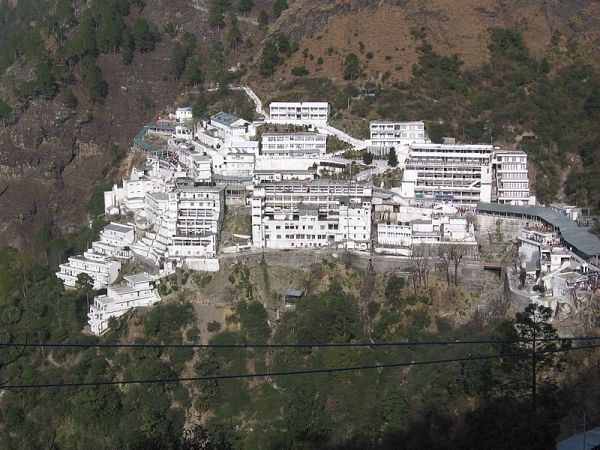
The symbolic significance of Vaishno Devi is intertwined with the Vaishno Devi shrine which can be found more than 5,000 feet above sea level on the slopes of the Trikuta Hills near the town Katra of Jammu and Kashmir. It is believed that a mere glimpse of maa Vaishno Devi bestows peace and prosperity and fulfills all wishes of sincere devotees.
Goddess Vaishno Devi is revered as the epitome of strength and protection. Her portrayal as a warrior goddess, often depicted riding a lion, symbolizes her fearless nature and her role as a protector of righteousness.
This aspect of Vaishno Devi resonates deeply with her devotees, who seek her blessings for courage and strength in their own lives. Her ability to combat and vanquish demons represents the spiritual strength required to overcome personal struggles and adversities.
Compassion and Motherly Love
Alongside her formidable strength, Vaishno Devi embodies the warmth and compassion of a nurturing mother. This duality reflects the Hindu belief in the nurturing aspect of the divine feminine. Her devotees view her as a caring mother who guides and supports them through life’s challenges, offering solace and protection. This motherly aspect of the Goddess is particularly significant, as it highlights the balance between power and tenderness, encouraging devotees to seek inner harmony.
Indomitable Courage to Surmount All Obstacles
Mostly Hindu Goddesses are also worshipped at home through idols or pictures of the concerned deity. But Mata Vaishno Devi is one of those rare Hindu Goddesses who is mostly only worshipped at specific temples associated with her.
Mata Vaishno Devi Temple in Jammu located in the Indian state of Jammy and Kashmir is located at the cave where the young form of Mata Vaishno Devi, Vaishnvi is said to have performed intense penance.
The temple is accessible through a 13 kilometer trek from the base camp of Katra. The trek that involves climbing through dense forests and rugged terrain, can be arduous for many. That is why it is said that a devotee is only able to visit the temple when the Goddess calls.
The arduous trek to reach Mata Vaishno Devi’s shrine and get her darshan (catch a glimpse of the Devi) is also symbolic of indomitable courage to surmount all odds and obstacles. Maa Vaishno Devi thus helps devotees overcome all difficulties and pressures once they catch a glimpse of her.
Hinduism is a symbolic religion. A pilgrimage undertaken at a temporal level is symbolic of cleansing and nourishment of the soul. There are many holy pilgrimage sites in Hinduism. The act of completing the yatra(journey ) is considered as important as the final Darshan of the Goddess. That is why it is said that if devotees under yatra to Maa Vaishno Devi shrine with a pure heart, and a good conscience, Mata will bless them with all happiness and wisdom.
Vaishno Devi Origins
Many legends are associated with the origins of Vaishno Devi. The most popular story behind her origin is her birth in south India in the home of Ratnakar Sagar.
Ratnakar and his wife had remained childless for a long time. Goddess Lakshmi, Saraswati, and Kali pooled their collective tejas or spiritual strength. Out of this formidable combination, a beautiful young girl was created. The three Goddesses charged this young girl with the responsibility of preserving righteousness in the world. They instructed the girl to be born in the house of Ratnakar who was an ardent devotee of the three Goddesses. The young girl was also asked to become a divine inspiration for all by spending her days devoted to meditation.
Vaishno Devi thus gets born as Ratnakar’s daughter. She was called Trikuta as a child. Later, Maa Vaishno Devi gets the name of Vaishnavi because of her taking birth from the lineage of lord Vishnu. According to legend, Trikuta sought the permission of her father to do meditation in the forest.
Vaishno Devi meets lord Rama
Her father agreed and thus Mata Vaishno Devi started meditating in the forest in the form of a 9- year old girl. While she was in the forest, delving deeper into the mode of devotion and meditation, lord Rama, the avatar of Vishnu known as the embodiment of Dharma(righteousness) saw her meditating in the forest during his exile.
Vaishno Devi, having understood his divine identity at once, asked him to marry her. But lord Rama was searching for Maa Sita, his wife, who was his consort. Thus, he told Vaishno Devi he could not marry her now. But he assured her that he would marry her at an appropriate time; when he assumes Kalki avatar at the end of Kalyug( the age we are currently in), he would take Vaishno Devi as his consort.
Vaishno Devi Shrine Origin
In the meantime, lord Rama asked Trikuta ( young form of Goddess Vaishno Devi ) to meditate in the cave found in the Trikuta range of Manik Mountains situated in north India.
He told her that until the right time comes for their union at the end of Kalyug, she should establish her residence at an ashram that would be set up for her at the base of the Trikuta hills, spending her days blessing devotees and relieving the suffering of human beings.
That’s how, according to legend, Vaishno Devi shrine in Jammu came into being, as Mata Vaishno Devi assumed the form of a rock, immersing herself in eternal meditation.
According to legend, the Mata Vaishno Devi shrine was discovered about 1,000 years ago after the Goddess appeared in the dream of an ardent devotee named Shridhar and showed him the location of the shrine. After this incident, it is said that the word of Vaishno Devi’s presence at that holy spot began to go around the 16th century onwards.
Then in the 1800s, Maharaja Gulab Singh, the first Dogra ruler of the princely state of Jammu and Kashmir, founded a religious charity known as the Dharmarth Trust. Under the tutelage of Dharmath Trust, the shrine started becoming more organized. However, as the temple began to attract a huge number of pilgrims, the shrine was handed to the government in the 1980s who were better equipped to manage the temple.
History of Mata Vaishno Devi Shrine
Mata Vaishno Devi shrine is said to be at least a million years old. It was initially mentioned in the Hindu epic Mahabharata.
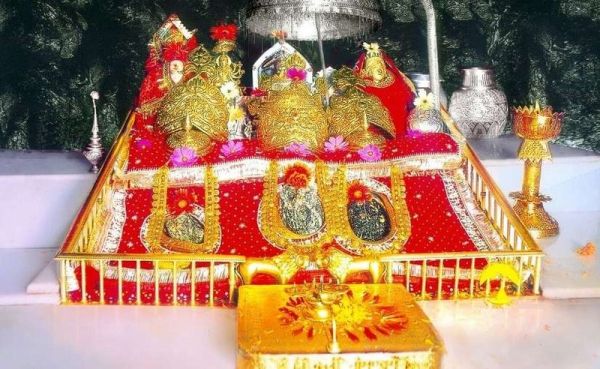
During the battle between the Pandavas and the Kauravas, Arjun meditated at Kurukshetra on the guidance of lord Krishna to obtain success in the battle. The divine manifestation of Shakti, the mother Goddess is addressed as “ Jambookatak Chityaishu Nityam Sannihitalaye” at this point of time. This means: one who resides in a shrine on the slope of the mountain in Jamboo ( Jamboo here refers to the state of Jammu ).
It is considered that the Pandavas were the ones who initially constructed the Kol Kandoli temple and the main bhawan. Kol Kandoli temple is situated in the Nagrota city of Jammu and Kashmir. Mata Vaishno Devi is established in this temple in the form of a Pindi( decked stones or tree stumps that are considered abstract manifestations of the Mother Goddess). It is considered auspicious to visit this temple before beginning the journey for Mata Vaishno Devi shrine.
Mata Vaishno Devi Representation
In the realm of Hindu art, Vaishno Devi is depicted with an aura of divine grace and majesty. Artistic representations often show her with a serene yet powerful demeanor, symbolizing her dual role as a fierce warrior and a compassionate mother. These depictions are not just visual representations but are imbued with deep spiritual meaning, serving as a source of inspiration and devotion for her followers.
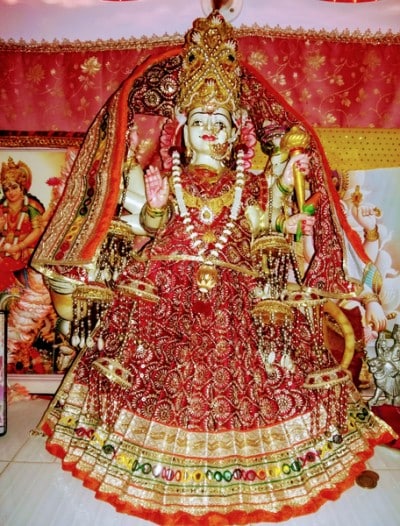
Mata Vaishno Devi is depicted as a beautiful Goddess dressed in red. She is often depicted with eight arms holding a trident, bow, arrow, lotus, mace, and sword. One of her hands is shown in the gesture of Abhay mudra. She is depicted riding a tiger.
Scriptural References and Symbolism
In Hindu scriptures, Vaishno Devi’s narrative is rich with symbolic meanings. Her stories and teachings are interwoven with broader themes of good versus evil, spiritual awakening, and the pursuit of righteousness. The scriptures portray her as a guiding light for spiritual seekers, symbolizing the journey towards enlightenment and the triumph of the human spirit. Her presence in these texts serves as a reminder of the divine protection and guidance available to all who seek it.
The symbolic significance of Vaishno Devi in Hinduism is profound, encompassing a wide range of spiritual and philosophical themes. Her representation in art and scripture serves as a beacon of hope and strength, inspiring devotion and spiritual growth among her followers.
Vaishno Devi’s Mythological Tales and Legends
Vaishno Devi and Bhairav Nath
As per lord Rama’s orders, Mata Vaishno Devi began to make the arduous journey to the described location in the north of India.
She thus wasted no time once she reached there and went into deep meditation. As her glory spread far and wide, many came to see her. One of these people was a man named Bhairav Nath who was so enamored by her beauty and grace that he wanted to marry her.
Bhairav Nath started harassing Mata Vaishno Devi. Initially, she ignored his overtures and fled up the mountain to a cave where she hoped to continue her meditation in peace.
Bhairav Nath was however adamant and he chased her all the way up to the cave. This is when Vaishno Devi assumed the form of Goddess Kali and cut off Bhairav Nath’s head.
When Bhairav Nath realized that the Goddess was not an ordinary mortal, he begged pardon and seeked forgiveness. Mata Vaishno Devi released him from the cycle of rebirth. She also blessed him by building a Bhairav Nath Shrine on the way to Vaishno Devi temple.
Vaishno Devi gave Bhairav Nath a blessing that any devotee who wishes to continue the Vaishno devi pilgrimage successfully must first pay their obeisance at the Bhairav Nath temple.
Vaishno Devi and Lord Rama
Another significant tale in the lore of Vaishno Devi is her encounter with Lord Rama, the hero of the epic Ramayana. As per the legend, during his search for his abducted wife Sita, Rama reaches the cave where Vaishno Devi is meditating.
Recognizing her as an incarnation of Shakti, lord Ram paid homage to her. Vaishno Devi asks lord Ram to marry her. Lord Ram, who is searching for his wife Sita abducted by Ravana in exile tells her that he cannot marry her in this birth. But he would take her as a consort when he assumes Kalki avatar at the end of Kalyug( the age we are in now). It is believed that when the sins of Kalyug would become too much to bear, lord Vishnu would take the Kalki avatar to dispel the darkness and ignorance of Kalyug and usher in a new era.
The Creation of the Vaishno Devi Shrine
The origin of the Vaishno Devi shrine, a sacred site for millions of devotees, is rooted in mythological lore. According to legend, Vaishno Devi, born as a young girl named Vaishnavi, was a devotee of Lord Vishnu. From a young age, she displayed a deep spiritual inclination and undertook severe penances to merge with the divine. Observing her devotion and determination, Lord Rama, during his visit, guided her to meditate in a cave in the Trikuta Mountains to elevate her spiritual journey.
The Transformation into a Holy Site
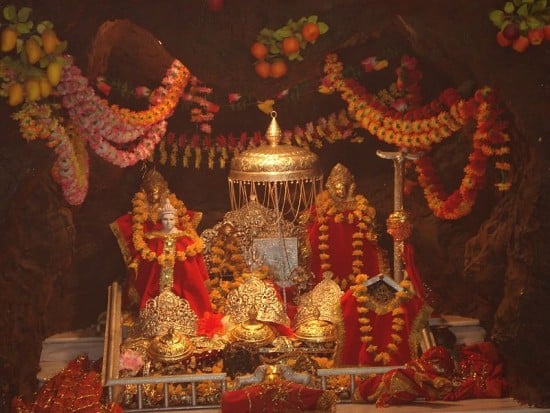
The cave where Vaishnavi meditated became the site of her transformation into a divine form, merging with the energies of Mahakali, Mahalakshmi, and Mahasaraswati. This sacred spot eventually evolved into the Vaishno Devi shrine, a symbol of divine motherhood and spiritual aspiration. The journey to this shrine, nestled in the mountains, is not just a pilgrimage but a metaphor for the soul’s journey towards divine consciousness.
It is believed that Goddess Vaishno Devi manifested herself here in the form of three natural rock formations known as three holy pindies. These pindies are believed to symbolize energy manifestations of the three forms of Shakti that together constitute Mata Vaishno Devi – Mahalakshmi, Mahasaraswati, and Mahakali.
Vaishno Devi in Spiritual and Cultural Context
The myths of Vaishno Devi are rich in spiritual allegories, offering profound insights into the journey of the soul. Her battles against demons are not just physical confrontations but represent the inner struggle against negative tendencies and ignorance. These stories symbolize the spiritual path of purification and enlightenment, where the divine feminine energy, as embodied by Vaishno Devi, plays a crucial role in guiding and protecting the soul.
Philosophical Underpinnings
The philosophical underpinnings of Vaishno Devi’s myths are deeply rooted in Hindu thought. They reflect the concepts of Dharma (righteousness), Karma (action), and Bhakti (devotion), illustrating how these principles are integral to spiritual growth. Her tales emphasize the importance of faith, devotion, and surrender to the divine will, underscoring the belief that divine grace is key to overcoming life’s challenges.
Cultural Impact and Reverence
Vaishno Devi’s influence extends beyond religious practices to cultural expressions. The pilgrimage to her shrine is a significant cultural event, drawing millions of devotees annually.
This journey is not just a religious ritual but a cultural phenomenon that brings together people from diverse backgrounds. Additionally, her story has inspired various forms of art, including music, dance, and literature, reflecting her integral role in Indian culture.
Role in Daily Practices and Festivals
In daily practices and festivals, Vaishno Devi’s presence is palpable. Her teachings influence the values and ethics of her devotees, shaping their way of life. Festivals dedicated to her are celebrated with fervor, involving rituals and customs that reinforce her cultural significance. These celebrations are not just religious observances but also times for communal harmony and spiritual renewal.
Devotion and Worship of Vaishno Devi
The most significant act of devotion to Vaishno Devi is the pilgrimage to her shrine in the Trikuta Mountains. This arduous journey is seen as a testament to the devotee’s faith and perseverance. Pilgrims undertake this journey with fervent devotion, chanting hymns and prayers, seeking the Goddess’s blessings for fulfillment and spiritual liberation.
Rituals at the Shrine
At the shrine, various rituals are performed as acts of devotion. These include offerings of flowers, fruits, and sweets, and the performance of Aarti and Bhajans (devotional songs). The act of Darshan (seeing the deity) is considered the climax of the pilgrimage, where devotees feel a profound connection with the divine.
The Significance of Vaishno Devi in Spiritual Guidance
Vaishno Devi is revered as a source of spiritual guidance. Devotees seek her blessings for not just worldly achievements but also for guidance on their spiritual path. Her role as a divine mother is seen as pivotal in guiding devotees towards righteousness and enlightenment.
Symbol of Unwavering Faith
The worship of Vaishno Devi symbolizes unwavering faith and the power of devotion. Her devotees believe that her grace can guide them through life’s trials and tribulations. This unwavering faith is a cornerstone of the worship of Vaishno Devi, embodying the belief in the transformative power of divine love and grace.
Vaishno Devi’s Manifestations and Forms
Vaishno Devi is believed to be a manifestation of the collective energies of Goddesses Mahakali, Mahalakshmi, and Mahasaraswati. Each of these aspects represents different facets of the divine feminine – from the fierce protector to the benevolent provider and the wise guide. These manifestations highlight the multifaceted nature of the goddess, embodying various divine attributes.
Symbolism in Forms
Each form of Vaishno Devi carries deep symbolic meaning. Mahakali represents the transformative power of time and change, Mahalakshmi embodies material and spiritual wealth, and Mahasaraswati symbolizes wisdom and knowledge. Together, they form a holistic representation of the divine feminine, catering to the diverse needs of the devotees.
Vaishno Devi in Various Cultural Depictions
Vaishno Devi is worshipped in various forms across different regions, reflecting the diversity of Hinduism. In some areas, she is worshipped primarily as Mahakali, while in others, the emphasis might be on Mahalakshmi or Mahasaraswati. These regional variations showcase the adaptability and inclusiveness of her worship.
Cultural Representations
In cultural representations, Vaishno Devi is depicted in various forms, from a benevolent mother to a fierce warrior. These depictions are not just artistic expressions but also convey the cultural interpretations of her divine attributes. They serve as a reminder of her pervasive influence in the spiritual and cultural tapestry of India.
These chapters delve into the spiritual essence, cultural impact, devotion, and various manifestations of Goddess Vaishno Devi, reflecting her profound significance in Hinduism and Indian culture.
Vaishno Devi Temples and Sacred Sites
The most prominent temple of Vaishno Devi is the sacred shrine located in the Trikuta Mountains of Jammu. This shrine, a cave temple, is more than just a religious site; it’s a symbol of faith and perseverance. The journey to the shrine, known as the Yatra, is a spiritual quest for millions. The path to the cave, marked by natural beauty and spiritual energy, is an integral part of the pilgrimage experience. It symbolizes the journey of life itself.
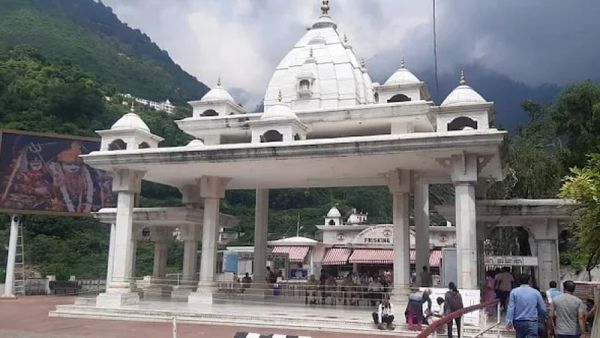
Some believe Mata Vaishno Devi shrine to be the holiest of all Shaktipeeths ( a place where the feminine divine Shakti has her home). It is believed that the skull or the right arm of Mata Sati, the first wife of lord Shiva fell here. It then manifested itself in the form of a Shaktipeeth.
However, one does find stone remains of a human hand in the cave of Mata Vaishno Devi in Jammu.
Mata Vaishno Devi yatra( journey ) is said to be one of the holiest pilgrimages of Hindus. It is believed that a devotee can visit the shrine only when the Goddess calls. That means, no matter how high and mighty or powerful you are, unless the Goddess calls, you do not have the privilege of her blessings. There is a famous saying in Hindi, “ Chalo bulaava aaya hai, Mata be bulaaya hai”. It means: Let’s go, the calling has come, the divine mother, the Goddess has herself called us.
Architectural Significance
The primary shrine of Vaishno Devi is a natural cave. However, several other temples dedicated to the Goddess exhibit unique architectural styles. These structures range from ancient to modern,. They are not just places of worship but also artistic representations of the goddess’s story. The architecture of these temples often incorporates symbols and motifs associated with Vaishno Devi,. The buildings themselves serving as a visual narrative of her divine saga.
Architectural and Artistic Representations
In temples dedicated to Vaishno Devi, artistic depictions often portray her in her various forms. Frescoes, sculptures, and carvings found in these temples depict scenes from her mythology, her battles, and her blessings. These artistic elements serve as a medium for devotees to connect with the goddess, offering visual insights into her divine attributes.
The temples of Vaishno Devi have influenced the temple culture in the region, setting standards for rituals, architectural styles, and the overall spiritual ambiance. The design and layout of these temples often facilitate communal gatherings, festivals, and spiritual discourses, making them centers of cultural as well as spiritual activities.
Festivals and Celebrations of Vaishno Devi
Navaratri Celebrations
Navaratri, the nine-night festival dedicated to the Mother Goddess, is celebrated with great fervor at Vaishno Devi temples. Each night is dedicated to a different aspect of the Goddess, with special rituals and prayers. The festival culminates in a grand celebration on the tenth day, known as Vijayadashami, symbolizing the victory of good over evil.
Special Pujas and Rituals
Apart from Navaratri, other festivals like Diwali and Vasant Panchami are also celebrated with special pujas dedicated to Vaishno Devi. These festivals are times of joyous celebrations, with the temples being adorned with lights, flowers, and decorations, creating an atmosphere of devotion and festivity.
Rituals and Customs in Vaishno Devi’s Festivals
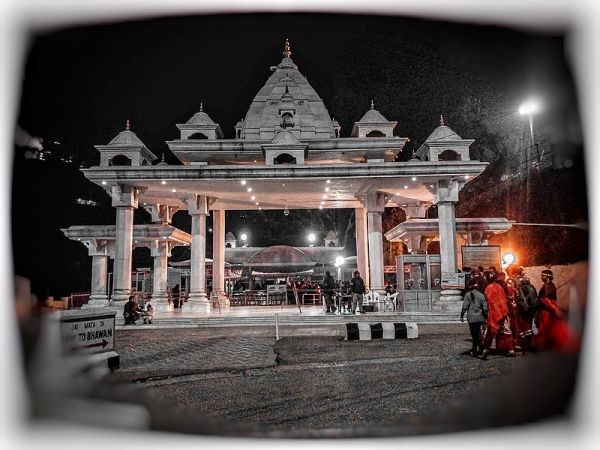
During these festivals, various rituals are performed. They include the chanting of hymns, offering of Prasad (sacred food), and performance of Aarti. These rituals are believed to invoke the goddess’s blessings and are performed with deep reverence and devotion.
Festivals dedicated to Vaishno Devi are also characterized by community participation. Devotees gather in large numbers to participate in the rituals, sing devotional songs, and share Prasad. These gatherings reinforce the sense of community and shared devotion, making the festivals a collective spiritual experience.
Symbols and Icons of Goddess Vaishno Devi
Symbolic Colors
The colors most commonly associated with Vaishno Devi are red and orange. They symbolize strength, energy, and the motherly qualities of the Goddess. These colors are prominently featured in temple decorations and devotees’ attire during festivals and rituals.
Sacred Symbols
The lion, Vaishno Devi’s mount, is a powerful symbol of her strength and majesty. Other symbols associated with her are the conch, the discus, and the trident. Each representing different aspects of her divine power.
Plants, Animals, and Other Elements Linked to Vaishno Devi
Certain plants and animals are considered sacred in the worship of Vaishno Devi. The Tulsi plant, for instance, is revered and used in daily rituals. The lion, as her mount, is venerated and often depicted in temple art and iconography.
The natural elements surrounding the Vaishno Devi shrine, like the mountains, streams, and cave itself, are imbued with spiritual significance. These elements are seen as manifestations of the Goddess’s presence, making the entire landscape a sacred space for her devotees.
Reflection and Closing Thoughts
The myths and worship of Vaishno Devi teach valuable lessons about strength, perseverance, and compassion. Her stories inspire devotees to face life’s challenges with courage and to embrace the virtues of kindness and benevolence. The Goddess’s journey is seen as a metaphor for the human quest for spiritual growth and enlightenment.
Embracing the Divine Feminine
Reflecting on Vaishno Devi’s role in Hindu mythology and spirituality encourages a deeper understanding of the divine feminine. Her presence reminds us of the nurturing, protective, and transformative power of the Goddess. Urging devotees to seek a harmonious balance in their spiritual and worldly pursuits.
FAQs about Mata Vaishno Devi
Vaishno Devi is a combined manifestation of Goddess Lakshmi, Kali, and Saraswati.
Mata Vaishno Devi shrine is located in the lap of Trikuta hills. In the north Indian state of Jammu and Kashmir.
Vaishno Devi is said to be born in the house of Ratnakar. He was an ardent devotee of Goddesses Lakshmi, Saraswati, and Kali. They lived in the south of India.
Mata Vaishno Devi is often depicted riding a tiger.
According to legend, the Kalki avatar of lord Vishnu will take Vaishno Devi as his consort at the end of Kalyug.
Featured Image Credit: No machine-readable author provided. Raju hardoi assumed (based on copyright claims)., CC BY-SA 3.0, via Wikimedia Commons

